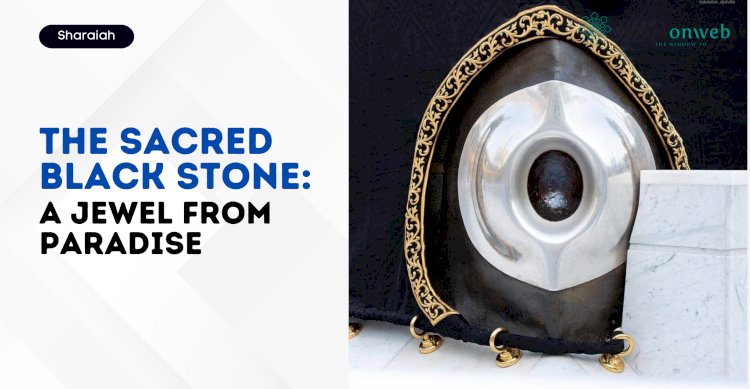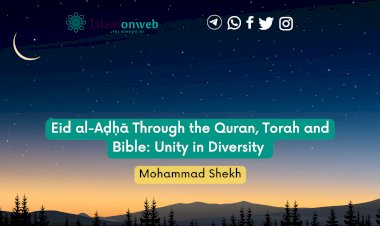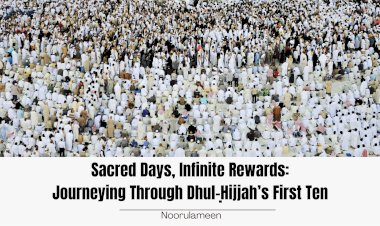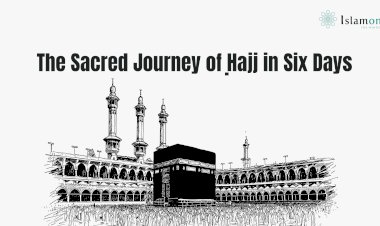The Sacred Black Stone: A Jewel from Paradise
The Black Stone (Hajar Al-Aswad) is a revered stone from paradise, brought down by the angel Jibreel (Gabriel) to become the most honoured part of the Kaaba. Abdullah ibn Abbas narrated that the Prophet Muhammad ﷺ said: "The Black Stone descended from Paradise" (Tirmidhi).
The Black Stone is the most revered stone on the face of the earth and the most honoured part of the Sacred House. This is why it is prescribed to kiss and touch it and to place one's cheek and forehead on it. Its location is on the eastern side of the second Yemeni corner, which is in the southeast, and its height from the ground is one and a half meters. It is not possible to describe it fully now because what is visible and can be touched and kissed are only eight small pieces of varying sizes, the largest of which is the size of a date. The rest is embedded within the structure of the Kaaba. It is reported that the stone comprises fifteen pieces, but the remaining seven pieces are covered with a mixture of wax, musk, and ambergris, which can be seen by anyone who touches the stone.
The length of the Black Stone was observed by Muhammad bin Nafi’ al-Khuza’i when the Qarmatians removed it in the fourth-century Hijri. He saw that only the head of the stone was black while the rest was white, and its length was about an arm’s length. The first person to encase the Black Stone in silver was Abdullah ibn al-Zubair to protect it, and subsequent caliphs and wealthy individuals followed this practice. The last to gift it a frame before the Saudi state was Sultan Muhammad Rashad Khan in 1331 Hijri, which was made of pure silver. King Abdul Aziz Al Saud later repaired this casing, and in 1375 Hijri, King Saud replaced the previous frame with another pure silver one.
#WATCH: Saudi Arabia's @hsharifain releases new specially processed images of details on the #BlackStone in the Grand Mosque in #Makkah
— Arab News (@arabnews) May 5, 2021
Read full story: https://t.co/lLAtY38e4K pic.twitter.com/YWxXhmcr3j
Black Stone Throughout History
The Black Stone has faced many incidents throughout history. The first was mentioned by Ibn Ishaq: when the tribe of Jurhum was expelled from Mecca, Amr ibn al-Harith ibn Mudhadh al-Jurhumi took the treasures of the Kaaba and the Black Stone and buried them in the well of Zamzam before fleeing. A woman from the tribe of Khuza’a saw this and informed her people, who then returned the Black Stone to its place.
In the pre-Islamic era, Khuwailid, the father of Khadijah, the Mother of the Believers, was one of the noblemen of the Quraysh who made significant contributions in Mecca. One of his greatest deeds was defending the Kaaba when Tubba’ attempted to take the Black Stone to Yemen. Khuwailid led a group of Quraysh men to confront Tubba’ and prevent him from taking the Black Stone. Allah thwarted Tubba’s plan, and he was unable to take it. Ibn al-Athir said: "Khuwailid confronted Tubba’ when he wanted to take the Black Stone to Yemen, and he was supported by a group of Quraysh. Tubba’ then saw a disturbing dream and abandoned his plan, leaving the Black Stone in its place."
During the life of the Prophet ﷺ and before his prophethood, a fire damaged the Kaaba, weakening its structure. The Quraysh were hesitant to rebuild it until Al-Walid ibn Al-Mughira took the first step by removing one of its stones. The Prophet ﷺ, while still a young man, participated in transporting the stones with the Banu Hashim and was the one who placed the Black Stone in its position, thus settling it with his blessed efforts. The tribes had agreed that the first person to enter the Kaaba would arbitrate their dispute, and it was the Prophet ﷺ who entered first, leading to a famous incident recorded in the books of Seerah (Prophetic biography).
The Black Stone remained in its place from the time of Qusay until the rebuilding by Abdullah ibn al-Zubair, who was the first to encase it in silver after it was damaged by the events of 64 Hijri. The Kaaba was burnt during the conflict between Ibn al-Zubair, who had taken refuge inside it, and the forces of Yazid led by Al-Husayn ibn Numayr, who catapulted the Kaaba, causing the fire that burnt it. This incident was repeated in 73 Hijri by Al-Hajjaj, after which the Abbasid Caliph Harun al-Rashid had the Black Stone set with diamonds and encased in silver.
One of the most egregious incidents involving the Black Stone was when the Qarmatians took it and hid it for 22 years, returning it to its place in 339 Hijri. Abu Tahir al-Qarmati invaded Qatif and occupied Mecca, seizing the Black Stone in 317 Hijri. In approximately 318 Hijri, they instituted a false Hajj to a large house in the village of Al-Jish in Al-Ahsa, where they placed the Black Stone, and commanded the people of Qatif to make pilgrimage to that place. However, the people refused, leading the Qarmatians to kill many inhabitants of Qatif.
It is said that Abu Tahir later moved the Black Stone to Kufa in 330 Hijri, but it was eventually returned to Al-Ahsa. Ibn Kathir stated: "In the blessed year of 339 Hijri, in the month of Dhu al-Qa’dah, the Black Stone was returned to its place in the House. The Turkish prince Bajkam offered fifty thousand dinars for its return, but the Qarmatians refused. They then sent it to Mecca without any compensation, arriving on a camel in Dhu al-Qa’dah of that year, and Muslims rejoiced greatly."
In the last days of Muharram in 1351 Hijri, a piece of the Black Stone was detached. Specialists prepared a chemical compound mixed with musk and ambergris. After the compound was prepared, King Abdul Aziz of Saudi Arabia, placed the piece back in its place with his own hand.

Close-up view of the Black Stone in the Kaaba captured in 2021 with a technique that uses stacked panoramic focus
The Story of Placing the Black Stone: Wisdom and Leadership of the Prophet ﷺ
When the Prophet Muhammad ﷺ was thirty-five years old, five years before his prophethood, the Quraysh tribe gathered to rebuild the Kaaba due to the cracking of its walls. The Kaaba remained as Ibrahim had built it, with stones stacked without mortar. The tribes divided the work among themselves, each taking responsibility for a section of the Kaaba. As they reached the spot for the Black Stone, a dispute arose among the Quraysh tribes about who would have the honour of placing the stone. The conflict escalated to the brink of war. Abu Umayyah ibn al-Mughira al-Makhzumi suggested that the first person to enter the gate of the Sacred Mosque would arbitrate the matter. They all agreed, and as they awaited the first arrival, the Prophet Muhammad ﷺ entered. Seeing him, they exclaimed: "This is the trustworthy one, we are satisfied with him, this is Muhammad." Upon reaching them and learning of the situation, he said: "Bring me a cloth." They brought it, and he placed the Black Stone in its centre. He then said: "Let each tribe hold one side of the cloth and lift it together." They did so, and when they reached the correct spot, he ﷺ took the stone and placed it in its position with his blessed hands.
The Prophet's ﷺ wisdom and profound intellect shone brightly in the story of the Black Stone. Even before his prophethood, he was known for his sound judgment and remarkable wisdom, which is evident in many instances of his life. His solution to the conflict over the Black Stone was equitable, wise, and accepted by all, preventing potential bloodshed and wars. Two significant outcomes were achieved: first, he ended the strife and potential combat among the Quraysh tribes; second, he ﷺ was honoured with placing the Black Stone in its position, a task they all desired.
The virtue of the Black Stone and Its Reverence
The Black Stone is the most honoured stone on earth, originating from paradise. Abdullah ibn Abbas narrated that the Prophet ﷺ said: "The Black Stone descended from Paradise, and it was whiter than milk, but the sins of the sons of Adam made it black" (Tirmidhi). He also narrated that the Prophet ﷺ said: "By Allah, Allah will raise it on the Day of Resurrection with two eyes by which it sees and a tongue that speaks, testifying to those who touched it in truth" (Tirmidhi).
Touching and kissing the Black Stone holds great virtue. Abdullah ibn Umar narrated that the Prophet ﷺ said: "Touching the Black Stone and the Yemeni Corner erases sins" (Ahmad). It is prescribed to touch the Black Stone at the start of Tawaf (circumambulation) and at the beginning of each circuit. If unable to kiss it directly, one should touch it with their hand and then kiss their hand. If even this is not possible, one should simply point to it. Nafi’ narrated: "I saw Ibn Umar touch the Black Stone with his hand and then kiss his hand, saying: 'I have not ceased to do this since I saw the Messenger of Allah ﷺ do it'" (Muslim). Umar ibn al-Khattab once said: "I know that you are a stone, you do not cause harm or benefit. If I had not seen the Prophet ﷺ kiss you, I would not have kissed you" (Bukhari).
Ibn Hajar explained that Umar's statement was to educate the people who were new to Islam and had previously worshipped idols, clarifying that touching the Black Stone is an act of following the Prophet ﷺ, not because the stone itself has any inherent benefit. This underscores the importance of following the Prophet ﷺ in all acts of worship, even when the wisdom behind them is not fully understood.

Rituals related to the Black Stone
The Black Stone, or Hajar Al-Aswad, holds a unique place in the rites of Hajj and Umrah. The Prophet Muhammad ﷺ taught us the proper way to venerate this sacred stone. When a pilgrim begins their Tawaf (circumambulation) around the Kaaba, it is Sunnah to start by facing the Black Stone. Here are the prescribed actions for honouring the Black Stone:
Kissing and Touching: If possible, one should kiss the Black Stone directly. If this is not feasible due to the crowd, one can touch it with their hand and then kiss their hand. Alternatively, one can touch it with a stick or another object and then kiss that object. If none of these are possible, simply pointing towards the Black Stone suffices, all the while saying "Allahu Akbar" (Allah is the Greatest).
Al-Zubayr ibn Arabi narrated that a man asked Ibn Umar about touching the Black Stone. Ibn Umar replied, "I saw the Messenger of Allah ﷺ touch and kiss it" (Bukhari).
Nafi’ reported that he saw Ibn Umar touch the Black Stone with his hand and then kiss his hand, saying, "I have not ceased doing this since I saw the Messenger of Allah ﷺ do it" (Muslim).
Abu Tufayl said, "I saw the Messenger of Allah ﷺ performing Tawaf around the Kaaba, touching the Black Stone with a stick and then kissing the stick" (Muslim).
Suwayd ibn Ghaflah narrated that he saw Umar kiss the Black Stone and embrace it, saying, "I saw the Messenger of Allah ﷺ honor you" (Muslim).
Takbir (Saying "Allahu Akbar") at the Black Stone It is Sunnah for the pilgrim to say "Allahu Akbar" each time they pass by the Black Stone during Tawaf.
Ibn Abbas reported that the Prophet ﷺ performed Tawaf on a camel, and every time he reached the Black Stone, he pointed towards it with something and said, "Allahu Akbar" (Bukhari).
Ibn Umar added the phrase "Bismillah" (In the name of Allah) before "Allahu Akbar" when touching the Black Stone (Al-Bayhaqi in Al-Sunan Al-Kubra, 5/79).
Avoiding Harm While Touching the Black Stone
It is crucial not to harm others when trying to touch the Black Stone. If one cannot reach it without causing harm, they should suffice with pointing towards it and saying "Allahu Akbar".
The Prophet ﷺ advised Umar, "O Umar, you are a strong man. Do not crowd the weak. If you find a clear space, touch it. Otherwise, say ‘Allahu Akbar’ and move on" (Akhbar Makkah by Al-Azraqi, though its chain includes an unknown narrator).
Ibn Abbas advised, "If you find a crowd at the corner, do not harm others, nor let yourself be harmed" (Al-Azraqi).
This guidance is particularly important for women, especially during times of heavy crowding.
Aisha, the Mother of the Believers, used to perform Tawaf away from men, covering herself with a garment. When a woman suggested they go and touch the Black Stone, Aisha replied, "Go yourself," and refused to mix with the men (Bukhari).
A maidservant told Aisha that she had circled the Kaaba seven times and touched the Black Stone twice or thrice. Aisha responded, "May Allah not reward you for pushing and shoving men. It would have been enough to say 'Allahu Akbar' and pass by" (Musnad Al-Shafi’i).
Inappropriate actions include interrupting the prayer before the Imam completes the Tasleem to touch the Black Stone, which is not permissible.
The Black Stone stands as a testament to the traditions of Islam, inviting reverence and careful adherence to the Sunnah while ensuring that the sanctity of the act does not lead to harm or disturbance among the pilgrims.
Disclaimer
The views expressed in this article are the author’s own and do not necessarily mirror Islamonweb’s editorial stance.

























Leave A Comment